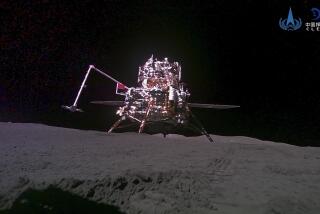Lunar Probe Fails to Show Water
- Share via
NASA’s Lunar Prospector ended its 19-month exploratory mission as planned by slamming into a crater at the moon’s south pole in the early hours of Saturday, but the collision did not kick up enough dust and debris for researchers to immediately determine whether the crater contains water.
Although as many as 20 telescopes around the world were watching for a plume of debris that never materialized, scientists still hope that analysis of other data collected during the crash might show evidence of water molecules. That could take days or weeks.
“It’s really too early to draw any conclusions,” said astronomer Edwin S. Barker of the University of Texas McDonald Observatory, one of the leaders of the project. “So far, we haven’t seen anything that says water or anything else.”
The presence of water on the moon would be the stuff of science fiction: It would sharply decrease the cost of establishing a colony there, and if enough were present, it could also be broken down to form oxygen for breathing and hydrogen for fuel.
The scientific team speculated that the probe’s impact may have occurred so deep in the crater that the plume did not clear its rim. Or it may have hit at such a shallow angle that it glanced off without kicking up much debris. Worst of all, it might have crashed somewhere other than the crater.
“We know it crashed,” said Texas astronomer David B. Goldstein. “We just don’t know where, exactly.”
NASA had given the project only about a 10% chance of producing useful results. So the failure to see water is not likely to constitute a big blow to the agency’s image, already sagging from other problems with probes. As recently as last week, NASA’s Deep Space 1 failed to capture an image of the asteroid Braille because the camera was pointed in the wrong direction. On Saturday, however, the probe had limited success when it sent infrared pictures of unknown quality.
Lunar Prospector was launched Jan. 6, 1998, and spent just over 18 months in lunar orbit, using five instruments to map the magnetic, chemical and gravitational characteristics of the moon. The $63-million project was scheduled to end Saturday.
Goldstein had suggested that the project might end, literally, with a bang in an effort to look for water on the moon’s surface.
Radar images of the moon in 1996 had suggested that ice might be present at the surface or just beneath it in one or more craters at the moon’s south pole, where it would be sheltered from the sun’s heat. One of Lunar Prospector’s instruments also detected hydrogen in the region, hinting at the presence of water.
Because the probe would be sending back no further data after Saturday anyway, Goldstein argued that it should be crashed into one of the craters where the presence of ice had been suggested. The impact, equivalent to crashing a two-ton car at more than 1,100 mph, could create a debris plume containing as much as 40 pounds of water, he calculated.
Intact water molecules in the plume would be instantly detectable by telescopes, while the presence of water molecule fragments produced by the heat of the impact would require more sophisticated analysis and take longer. Detection of either, however, would signal the presence of water deposits.
But getting the probe into the crater was a delicate task. Crucial firings of its rocket were carried out while the probe was behind the moon and out of contact with Earth. And because of its orbital dynamics, it was to just barely clear the rim of the crater on its way to the crater floor.
If the rockets fired as predicted, researchers would not have received another signal from the craft after it went behind the moon, and it was set to crash at 2:52 a.m. Saturday.
Controllers believe all of those mechanics went as planned and that the probe performed as expected.
“Everything went normally, so we have every reason to believe it made it to the impact site,” said David Folta of the Goddard Space Flight Center, which was in charge of guidance. “There is no reason to believe we didn’t get to where we wanted to go.”
Except that there was no visible plume. The only hope now is that instruments may have picked up some traces of water vapor that will be revealed in coming weeks.
One aspect of the mission was a definite success. Lunar Prospector carried about an ounce of the ashes of geologist Gene Shoemaker, who died in a 1997 automobile crash in Australia. Shoemaker had fervently hoped to be an astronaut but was disqualified because of Addison’s disease. He later taught geology to the astronauts who did make it to the moon and became an expert in searching for asteroids.
A former geology professor at Caltech, he was one of the discoverers of the comet Shoemaker-Levy, which crashed into the surface of Jupiter in 1994 in a series of spectacular explosions. He is the first human to have his ashes interred off the Earth.
(BEGIN TEXT OF INFOBOX / INFOGRAPHIC)
The mission of Lunar Prospector was to provide a detailed map of the Moon’s surface composition and information about its origin, evolution and current state.
1. Probe put into an elliptical orbit to increase the angle of entry.
2. Final time-delayed commands sent to probe before it went behind the moon.
3. Angle of impact was so low that the spacecraft was not visible upon approach.
4. Earth and space-based telescopes, using Infrared detectors, would have been able to see any water vapor in the short-lived debris plume. However, there was no visible dust.
Source: NASA, University of Texas






